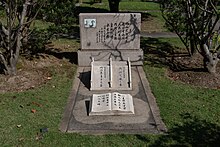Mausoleum of Soong Ching Ling
| Mausoleum of Soong Ching Ling, Honorary Chairman of the People's Republic of China | |
|---|---|
中华人民共和国名誉主席宋庆龄陵园 | |
 Foreigners' graveyard | |
 | |
| Details | |
| Established | 1909 |
| Location | |
| Country | China |
| Coordinates | 31°11′51″N 121°24′22″E / 31.197382°N 121.406123°E |
| Type | National |
| Website | www |
The Mausoleum of Soong Ching Ling, official the Mausoleum of Soong Ching Ling, Honorary Chairman of the People's Republic of China, is a public cemetery in Shanghai, China.[1] It houses the memorial hall of Soong Ching-ling and her family tombs, along with notable Chinese and foreign figures in Shanghai.[2] The cemetery was called the Shanghai International Cemetery, before the burial of Soong Ching-ling.
History
[edit]In October 1909, Jing Runshan, a businessman from Zhejiang, purchased 20 mu of land in the western suburbs of Shanghai to establish a garden, which was completed in 1914. In 1917, Jing's wife, Wang Guozhen, expanded the garden by an additional 55.6 mu to the west and renamed it the International Cemetery. In September 1934, the cemetery was taken over by the Bureau of Health of the Shanghai Municipal Council,[3] and further expanded into a public cemetery, covering an area of 81,800 square metres (880,000 sq ft).[4]
In 1918, the Soong family bought graveyard within the cemetery as their family graveyard, following the death of Charlie Soong. In August 1931, the Soong sisters and brothers buried their parents together, following the death of their mother Ni Kwei-tseng.[5]
During the Cultural Revolution, the cemetery suffered extensive devastation at the hands of the Red Guards. They desecrated the Soong family tombs at the International Cemetery, toppling gravestones and exhuming the remains of Soong Ching-ling's parents. This deeply shocked and saddened Soong. Chinese Premier Zhou Enlai intervened, ensuring the restoration of her parents' graves.[6]
In 1973, the Civil Affairs Bureau of Shanghai nationalised the 30 mu of land surrounding the Soong family graves. By 1981, the entirety of the International Cemetery had been nationalised.[7]
On 29 May 1981, Soong Ching-ling died in Beijing and was buried in the Soong family graveyard in June. In January 1984, the cemetery was re-organised as the Mausoleum of Soong Ching Ling, Honorary Chairman of the People's Republic of China, which came under state protection in February 1982.[5][8] Before Soong Mei-ling died in 2003, she had refused to be buried in Taiwan and hoped to be buried with her parents in Shanghai, which was not acceptable for the Kuomintang. As a result, she was buried in the United States instead.[9]
Notable burials
[edit]

In addition to the Soong family, other notable Chinese figures buried in the cemetery includes:[7][4]
| Grave # | Name | Lifespan | Description |
| 1 | Jin Zhonghua | 1907-1968 | Founder of the China News Service; Vice-mayor of Shanghai |
| 2 | Yang Xingfo | 1889-1933 | Chinese social activist who was assassinated by Juntong in 1933 |
| 5 | Xie Jinyuan | 1905-1941 | Chinese general who commanded the Defense of Sihang Warehouse |
| 7 | Wang Pingnan | 1893-1950 | Shanghai guerrilla leader |
| 19 | Zhang Leping | 1910-1992 | Chinese cartoonist; author of Sanmao |
| 20 | Zhou Xinfang | 1895-1975 | Beijing Opera performer |
| 21 | Ma Xiangbo | 1840-1939 | Founder of Fudan University |
| 53 | Yu Zhenfei | 1902-1993 | Kunqu performer |
| 73 | Yang Du | 1874-1931 | Chinese political activist |
| 74 | Li Zhongshi | 1886-1919 | Chinese revolutionary |
Lu Xun was buried in the cemetery between 1936 and 1956, before moving to Hongkou Park.[10] Kanzō Uchiyama and his wife Inoue Mikiko was also buried in the cemetery. Korean independence leaders, including Park Eunsik, No Baek-rin and Shin Gyu-sik, was once buried in the cemetery before relocated to South Korea.[2]
Administration
[edit]The cemetery is managed by the Management Office of the Mausoleum of Soong Ching Ling, Honorary Chairman of the People's Republic of China,[11] which is affiliated with Shanghai Sun Yat-sen and Soong Ching-ling Cultural Relics Management Committee.[12]
References
[edit]- ^ "Expats visit Soong Ching Ling mausoleum ahead of tomb-sweeping day". SHINE. Retrieved 2024-11-25.
- ^ a b "陵园概况". Archived from the original on 2020-09-18. Retrieved 2010-05-16.
- ^ "存档副本". Archived from the original on 2020-11-03. Retrieved 2020-09-12.
- ^ a b "虹桥路万国公墓". Archived from the original on 2012-11-27. Retrieved 2010-05-16.
- ^ a b "宋庆龄陵园建设的前前后后". Archived from the original on 2012-11-27. Retrieved 2010-05-16.
- ^ "宋庆龄在"文革"艰难岁月中". china.com. 2006-05-30. Archived from the original on 2012-04-29. Retrieved 2018-09-18.
- ^ a b "上海区县志 >> 区志 >> 长宁区志 >> 第三十四编文化 >> 第五章文物、史迹 >> 第二节 万国公墓". Archived from the original on 2009-01-09. Retrieved 2019-04-15.
- ^ Qin, T.; Wang, Y.; Li, J.; Tang, Z.; Dai, S. (2021-08-28). "Conservation and Maintenance Concepts of Soong Ching Ling's Dolomite Marble Statue in Shanghai and Supporting Survey Methods". The International Archives of the Photogrammetry, Remote Sensing and Spatial Information Sciences. XLVI-M-1-2021: 579–584. doi:10.5194/isprs-archives-XLVI-M-1-2021-579-2021. ISSN 1682-1750.
- ^ Müller, Gotelind (2021). Chinese Grave Problems: The Historical Trajectory of the Republican-Era, Sun-Chiang-Soong Families as Mirrored in Their Tombs. [object Object]. doi:10.11588/xarep.00004474.
- ^ "书摘:鲁迅先生墓的变迁". Archived from the original on 2018-10-01. Retrieved 2010-05-16.
- ^ 孙中山宋庆龄资讯网站/关于我们 Archived 2012-01-01 at the Wayback Machine,上海市孙中山宋庆龄文物管理委员会
- ^ 上海市人民政府机关事务管理局主要职责 Archived 2016-03-29 at the Wayback Machine,“中国上海”政府门户网站
